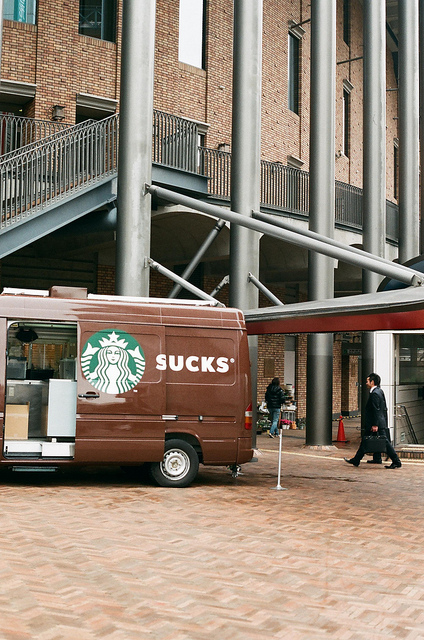On Starbucks
Perfect typeface placement in relation to the sliding door.
I don’t care that they make money. That’s fine. The chief problem with Starbucks is of course the taste of the coffee itself.
Beans. Starbucks buys a bazillion tons of beans from all over the world. They don’t buy high-end stuff (despite what the labels claim), but rather middle to low grade high volume commodities. The real junk goes into the cheap pre-ground stuff in metal cans at the grocery store. They use higher-grade beans than that, but it isn’t worth it to spend a lot of extra money for the next reason.
Bulk Variance. Large bulk means wide variety. Wide variance in bean origin and quality means that Starbucks has to deal with coffee from all over the place. They may get a whole ship load of stuff from Brazil, followed by another boatload from Indonesia. There are good crops, bad crops, good batches, bad batches. It’s all over the place. They HAVE to homogenize everything as much as possible to keep a consistent product. They can’t have the quality of the coffee going up and down throughout the year or over the course of years. Customers expect it to be the same every time. They have to adjust their roasting and processing to a normalized middle. If they get a really good batch of coffee in, they can’t let it stay good! They HAVE to mix it in with all the other stuff or it will stand out as being different. For Starbucks, with over 10,000 locations, different is BAD. Really bad. Consistency and quality control are the name of the game.
Roast. How do you achieve consistency with a finicky agricultural product like coffee? The main answer is to roast it dark. Roasting the coffee dark burns away much of the nuance, eliminates offensive flavors from low grade beans, and brings the flavor down to an acceptable (depending on how you look at it) lowest-common-denominator. Trying to raise the bar would threaten consistency, making their thousands of espresso machines across the country require constant calibration. The seasonal changes would also confuse and annoy customers. Their business model demands that they keep the bar low. Not TOO low, but a very stable and well-defined level of mediocrity.
It’s the constraint they have put on themselves to grow big and it’s worked very well for them.
BUT, for all of you out there who are in love with the wonderful flavor of coffee and appreciate all the little nuances, you are going to eventually desire something high-grade roasted relatively light, and brewed carefully without a lot of additives. There are plenty of you today and so this side of the coffee/foodie business is booming as well. Starbucks can’t compete on this level and it doesn’t try to. Saying Starbucks sucks by comparing them with a high-end small-batch roaster is like saying McDonalds sucks because the don’t use Kobe beef in their burgers. The comparison isn’t meant to be made, though I think that Starbucks has sometimes hyped their own products a bit too much, inviting this kind of criticism. McDonalds doesn’t have that problem.
In the “if you can’t say anything nice don’t say it at all” department, I will add a few positive comments about Starbucks.
Their baked goods (scones, muffins, etc.) are generally very tasty. They suffer from being pre-frozen and they are definitely overpriced, but the recipes themselves really are top notch. The pumpkin muffins, the layered cranberry orange scones, the morning buns – are all pretty dang good. I have often had FAR worse at local joints across the country touting their allegedly wonderful fresh-baked fare. You can’t just throw any old cookie on the counter and assume you have a leg up on the big corporate cafe. They’ve done their homework.
OK, I’ll say one more nice thing. Their pumpkin spice syrup is a chemist’s masterpiece. Everyone else’s imitation products (even the once that contain real pumkin puree!) fail to strike the proper balance in my opinion. Every autumn they sell these things as fast as they can make ’em and they deserve to.
Filed under: Uncategorized on October 16th, 2012

Leave a Reply